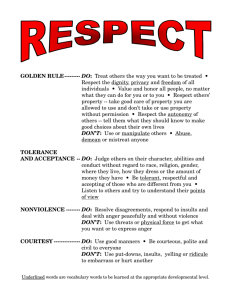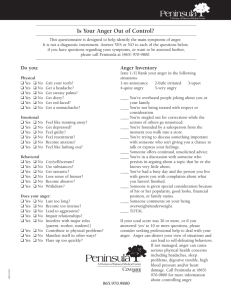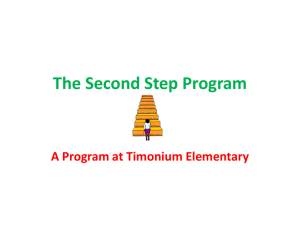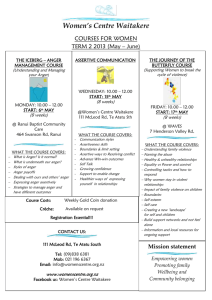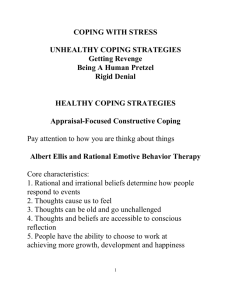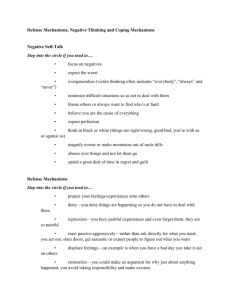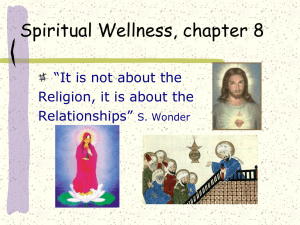The Four Faces of Anger
advertisement
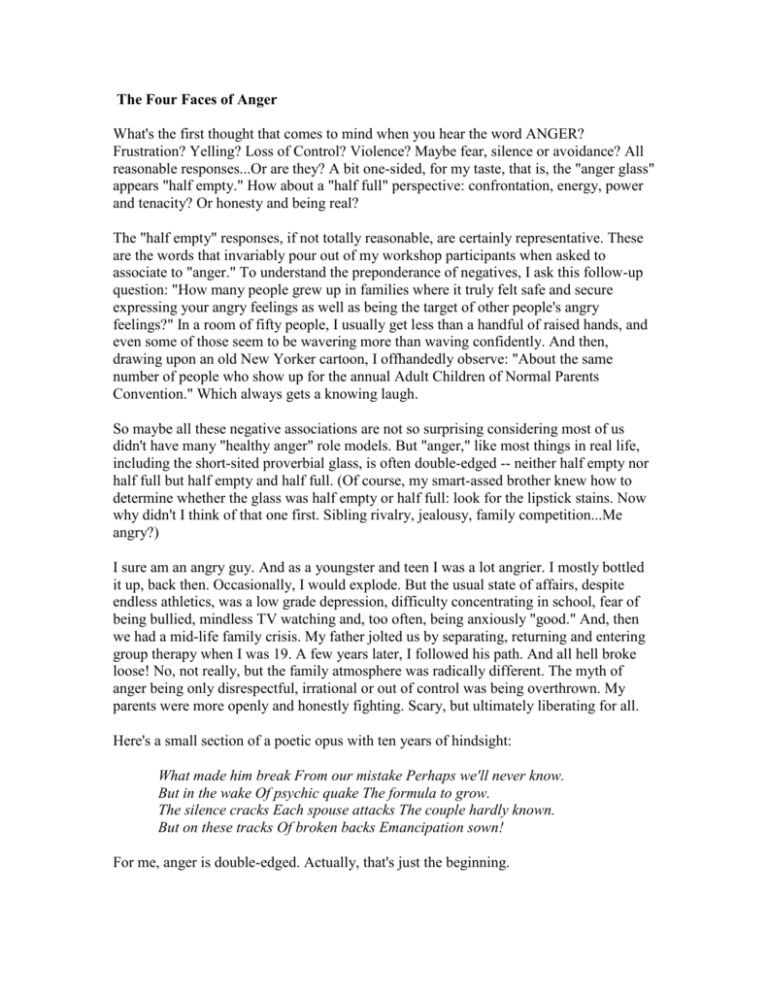
The Four Faces of Anger What's the first thought that comes to mind when you hear the word ANGER? Frustration? Yelling? Loss of Control? Violence? Maybe fear, silence or avoidance? All reasonable responses...Or are they? A bit one-sided, for my taste, that is, the "anger glass" appears "half empty." How about a "half full" perspective: confrontation, energy, power and tenacity? Or honesty and being real? The "half empty" responses, if not totally reasonable, are certainly representative. These are the words that invariably pour out of my workshop participants when asked to associate to "anger." To understand the preponderance of negatives, I ask this follow-up question: "How many people grew up in families where it truly felt safe and secure expressing your angry feelings as well as being the target of other people's angry feelings?" In a room of fifty people, I usually get less than a handful of raised hands, and even some of those seem to be wavering more than waving confidently. And then, drawing upon an old New Yorker cartoon, I offhandedly observe: "About the same number of people who show up for the annual Adult Children of Normal Parents Convention." Which always gets a knowing laugh. So maybe all these negative associations are not so surprising considering most of us didn't have many "healthy anger" role models. But "anger," like most things in real life, including the short-sited proverbial glass, is often double-edged -- neither half empty nor half full but half empty and half full. (Of course, my smart-assed brother knew how to determine whether the glass was half empty or half full: look for the lipstick stains. Now why didn't I think of that one first. Sibling rivalry, jealousy, family competition...Me angry?) I sure am an angry guy. And as a youngster and teen I was a lot angrier. I mostly bottled it up, back then. Occasionally, I would explode. But the usual state of affairs, despite endless athletics, was a low grade depression, difficulty concentrating in school, fear of being bullied, mindless TV watching and, too often, being anxiously "good." And, then we had a mid-life family crisis. My father jolted us by separating, returning and entering group therapy when I was 19. A few years later, I followed his path. And all hell broke loose! No, not really, but the family atmosphere was radically different. The myth of anger being only disrespectful, irrational or out of control was being overthrown. My parents were more openly and honestly fighting. Scary, but ultimately liberating for all. Here's a small section of a poetic opus with ten years of hindsight: What made him break From our mistake Perhaps we'll never know. But in the wake Of psychic quake The formula to grow. The silence cracks Each spouse attacks The couple hardly known. But on these tracks Of broken backs Emancipation sown! For me, anger is double-edged. Actually, that's just the beginning. The Four Angry "I"s In addition to subjective experience, our language has a unidimensional tilt when defining anger. According to the The Random House Dictionary of the English Language: The Unabridged Edition, anger is "a strong feeling of displeasure and belligerence aroused by real or supposed wrong." However, a clinical description is broader than a lay one. Anger is a state of heightened activation or arousal of the autonomic nervous system (for example, increased heart rate, rapid breathing, flushed face, chest pains, sweaty palms, etc.) that is fueled by our cognitive - conscious and unknowing - interpretations. You experience those "Four Angry 'I's," that is, you have a palpable sense of: 1. Injustice. A rule of conduct, a cherished belief or instrumental goal is being threatened or abused; you see yourself (also others with whom you are psychologically dependent or connected) as a victim of an injustice, unfairness or disloyalty. 2. Injury. You feel disrespected, discarded or ignored; there's a sense of insult and humiliation along with injury -- often psychological, at times also physical. 3. Invasion. Your freedom, autonomy, boundary and personal space are perceived to be constricted, disrupted or violated; your identity and bodily and/or psychological integrity are being threatened or attacked. 4. Intention. There is an energy and determination to do something about the above injustices, injuries and invasions; you are ready - reflexively and/or purposefully to challenge the status quo. So anger is a potential range of feelings, from irritation and determination to outrage and fury. Its breadth, depth, intensity and interactive potential is often forged by how one looks at the world through his or her "Four Angry 'I's." As I once wrote: Anger! That double-edged power source. It's the high octane emotion for blazing performance and for igniting a legitimate grievance. Yet, when it's bottled up we smolder away; when we erupt it may engulf us. And, when we are the target of a volatile flame thrower, there will be scars. (Gorkin, 1986) A Multifaceted Model It's time to flesh out and attempt to capture (more likely coax) this wide ranging, ever changing creature. Let's examine the apparent contradictions within "anger" and try to make sense of its protean nature and multi-function. To do this, let me sketch my "Four Faces of Anger" Model. To break out of a unidimensional box, try thinking about the interpersonal expression of anger along these two dimensions: Is your anger expression "purposeful" or "spontaneous"? Is your anger expression "constructive" or "destructive"? Let me briefly and loosely define my terms: "Purposeful" - when anger expression is intentional, with a significant degree of consideration or calculation; there is also a significant degree of self-control "Spontaneous" - when anger expression is immediate with little premeditation or planning; there is little-moderate self-control "Constructive" - when anger expression affirms and acknowledges one's integrity and boundary without objectively intending to threaten or violate another's integrity or appropriate boundary "Destructive" - when anger expression defensively projects and rigidly fortifies one's vulnerable identity and boundary by intending to threaten or violate another's integrity and appropriate boundary (whether the intention is conscious or not) Returning to our model, the 2x2 matrix yields four possibilities: 1) Purposeful and Constructive Anger Expression 2) Purposeful and Destructive Anger Expression 3) Spontaneous and Constructive Anger Expression 4) Spontaneous and Destructive Anger Expression Four Faces of Anger Matrix with Box1-Box2-Box3-Box4 labels. Box 1 Purposeful and Constructive Anger Box 2 Purposeful and Destructive Anger Box 3 Spontaneous and Constructive Anger Box 4 Spontaneous and Destructive Anger The Four Faces of Anger Game To understand the multifaceted nature of anger expression, let's play "The Four Faces of Anger Game." A. Let's start with Box 1. What word comes to mind when you read Purposeful and Constructive Anger Expression? If a word or phrase doesn't immediately come to mind, does an image or, even, an example of what you might say when expressing this kind of anger? My choice is "Assertion." Are you surprised? So many people associate anger with yelling and being out of control, that they don't associate assertion and anger...it's too rational. But expressing anger can happen with a firm, basically controlled tone of voice and volume, direct eye contact, a confident posture that's neither aggressively forward nor robotically restrained. To illustrate the four faces, we'll follow the interaction between a mother and her eighteen-year-old daughter, after the daughter, having used the family car, came home late and did not call. Notice how the anger expression changes as we focus on each interactive "face." The mother addressing her eighteen-year-old daughter, the following morning: "I'm angry. I let you have the car Friday night with the understanding you'd be home by 1:00am. (Author's note: There's been inflation in permissiveness since the time of Cinderella.) Or, if you were going to be late, we agreed you'd call beforehand. When I didn't hear from you, I was very worried. What happened? I want to talk with you about the car borrowing policy, and the consequences if this happens again." With assertive confrontations, the communicator takes responsibility for her emotions and clarifies her expectations and limits. While sometimes requiring premeditation, "I" messages are not necessarily intellectualized or overly rational. In fact, while typing these two examples, too bad you couldn't see the motion of my fingers as they firmly rapped, more than touched, the keyboard. "I" messages are infused with nonverbal cues and energy. B. For Box 2, what comes to mind when you read Purposeful and Destructive Anger Expression? Again, try for a word, image or expressive statement. My preference is "Hostility." Now hostility can take many guises, from condescending comments and being highly judgmental, to "scarcasm" and put down humor, to planning to get even when you feel slighted or injured. And passive-aggressive lateness or forgetfulness certainly falls under this category. In our "taking the car and getting home late vignette," how do you feel about a mother reacting to her daughter in this manner?: "I can't believe how irresponsible you were last night. You didn't call. You made me sick with worry. You expect me to trust you with the car? We'll see when you get the car again," said with a sneer and a haughty tone. Quite a difference from the assertive response. Plenty of those blaming and judgmental, globally hostile, potentially guilt-inducing "acc-you-sations." Know any such "blameaholics?" C. For Box 3, what word comes to mind when reading Spontaneous and Constructive Anger Expression? Many people find this combination a most challenging association. That's not so surprising when anger is often linked with being belligerent or dangerously out of control. Let me reveal my choice by providing some recent historical context. I suspect you can remember watching or listening to the highly charged Clarence Thomas-Anita Hill hearings? Do you recall having any strong feelings? Did any cherished principles seem under attack? Perhaps it stirred some "passionate" beliefs? That's my association: "Passion." Now "passion" is a very intriguing word. In fact, let's digress for a moment. What's the first thought when you read "passion"?: "Intense emotion." "Desire." "Love." Hey, let's go for the "s"-word. (In my current hometown, Washington, DC, we know what the "s"word for passion is..."Senator." And you thought I was going to say "sex." How could you?) Actually, the "s"-word for passion in most dictionaries is neither sex nor Senator, nor even "silk," as ventured by one imaginative workshop participant. The long-awaited, if not long-suffering, "s"-word for passion is... just that - "suffering." As in the "passion play": the sufferings of Jesus or, more generically, the sufferings of a martyr. (Imagine, all this time I never knew my Jewish mother was such a passionate woman. Just kidding, mom. ;-) Let's go back to the mother-daughter late night (actually early morning) interaction. This time from a passionate perspective. Now, however, the mother, not being able to sleep, meets the daughter at the door, and spontaneously confronts her: "What the heck happened? I was expecting a call. I'm angry. I'm up because I was terribly worried and couldn't sleep." After the daughter attempts a brief explanation (and the mother is assured of her safety) the mother, aware of her own difficulty listening, as well as her increasingly loud voice and shaky tone, continues: "I can tell I'm too upset to talk about this now. I'm glad you're home. I'm going to bed, and we'll discuss this incident, including rules for using the car, later in the morning." Passion is sparked by pure emotion and pain. However, there's a spontaneous response, not a reaction. This person still has a sense of self-integrity and the other's boundary. Passion with proportion is possible. A key point is that confrontations don't have to be wrapped up in one setting. Choosing a temporary retreat for regrouping and refocusing can prove most constructive. This approach is critical, especially if you have: a) reservations about turning the confrontation into a "win-lose" or a "right-wrong" battle, b) hope not to damage the relationship, and c) want both parties to learn and/or gain from the interaction. D. Finally, with Box 4, what's your association to Spontaneous and Destructive Anger Expression? This is perhaps the easiest, as it seems to conform with most people's concept of anger. There are many good answers: "Violence." "Screaming." "Hitting." My choice is "Rage." What's your mental picture of a rage state. Someone who is increasingly loud, displaying a string of profanities or threats, belligerent body posture, menacing gestures...blindly out of control. And often feeling victimized, betrayed and self-righteous about their rage. Of course, don't overlook the condition of "smoldering rage," with a low threshold for becoming unglued. Another important clarification involves distinguishing being "outraged" from being "inraged." (I've coined "inraged" to sharpen the contrast with "outraged" and to differentiate "inraged" from the more generic "enraged.") When terrorists blow up a US government building or plant a bomb on an airplane, one is easily outraged by such unjust, injurious and invasive actions. There is a seemingly clear, external (criminal) target to which all legal action and sanction should be and, hopefully, will be directed. When we are outraged, our emotional reaction is understandable, if not fully rational; our anger expression, however, if not careful or conscious, can cross the "constructive" vs. "destructive" boundary line. In fact, returning to our matrix model, you might visualize "outraged" as being near, if not on, the border of "passion" and "rage." In contrast, "inraged," or the Box 4, matrix term "rage," is invariably a destructive state. The inraged individual's exaggerated emotional reaction is fueled as much, if not more, by still unresolved hurts and humiliations than by actual, immediate stimulus-andresponse provocation. These never healed wounds can generate biased perceptions or highly exaggerated interpretations regarding the infliction of injustices, insults, injuries and invasions. I refer to these folks as having (or depending on their volatility) being psychic "hot buttons." They are just waiting, many times wanting, to be set off. And the trigger for a hot reactor may be trivial, simply an accidental or unintentional glance, word or touch. Let's revisit the mother-daughter encounter, for our final, fiery illustration. The mother, furious at her daughter's late return, explodes: "You inconsiderate witch. I should slap you silly," while raising her hand, as well as her voice, in a menacing manner. "I'm here, scared to death, not knowing what the hell's happened to you. Whether you busted up the car, have been raped? How the hell should I know. Do you call? No, you couldn't give a G-d damn. I'll fix your ass later. Get out of my sight." Whether the first violation of her mother's expectations or (more likely) not, the mother's reaction is clearly personalized and exaggerated, threatening and abusive. Her lashing anger especially stings when loaded with cutting profanity. A tendency for imagining the worst - "catastrophizing" - acutely heightens mom's anxiety. Not only can't the mother hear her daughter out, she can't tolerate the sight of her. Actually, she can't stand her own emotions. The mother may well need to project her own subconscious past associations to helplessness, panic and being out of control. Sadly, she, herself, has likely been a target of a volatile parent, spouse or authority figure. End Game Four Faces of Anger Matrix with Assertion-Hostility-Passion-Rage in proper boxes. Debunking the notion of anger and its expression as being a unidimensional concept is a fundamental goal of the anger association game. By combining the "Purposeful""Spontaneous" and "Constructive"-"Destructive" dimensions we are able to generate distinct anger expression profiles: Assertion, Hostility, Passion and Rage. Hopefully, the four matrix faces and interactive scenarios provide common sense images and verbal handles for grasping and differentiating the broad and nuanced emotional-behavioral responses of anger. Clearly, this is vital for challenging the one-sided, negative image of anger. Perhaps most important, the "Four Faces of Anger" Model can be a tool for your own, as well as your clients' understanding and acceptance of the naturalness and power of aggression and anger expression. And with enhanced awareness, hopefully, we all will experience and communicate anger in a more responsible and productive manner. Next edition I will use an organizational case study - a conflict between a problematic manager and his assistant - to illustrate the process component of the "Four Faces of Anger" Model: the matrix as an evolutionary framework for transforming self-defeating rage, proceeded by imaginative hostility, into passionate exploration and an assertive plan of action. Constructive Destructive Purposeful Assertion Hostility Spontaneous Passion Rage References Gorkin, Mark, "Anger or Aggression: Confronting the Passionate Edge," Legal Assistant Today, Winter 1986


